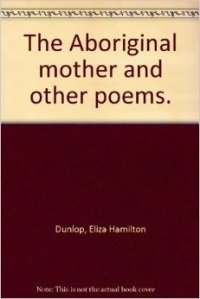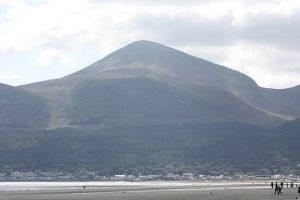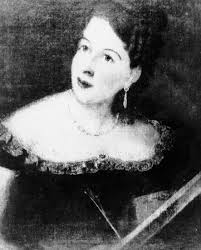A Feature on a neglected Irish-Australian poet
By Katie Hansord
Eliza Hamilton Dunlop (also published under her initials, EHD) has recently gained recognition as a significant colonial Australian poet and ethnographer.
Born in 1796 in Co Armagh, she died in 1880 in Wollombi, New South Wales. She was married twice, first to James Sylvius Law, by whom she had a daughter; Mary Sophia Georgina Law and then to David Dunlop with whom she had four children. Facing financial difficulties, they emigrated aboard the Superb, arriving at Port Jackson in 1838.
By 1839 David Dunlop had been appointed police magistrate and protector of Aborigines at Wollombi and Macdonald River, and held office until 1847. Eliza Dunlop contributed poetry to a number of colonial newspapers, and was also a playwright, a writer of short stories, and a passionate advocate of human rights with a keen interest in politics. Her great grand-daughter, Margaret De Salis notes that this interest included her numerous letters to Alderman William Taylor Copeland, who was active in Ireland as a Whig politician. I want to delineate Dunlop’s importance as an early nineteenth century Irish-Australian woman writer and consider some aspects of the political relevance of her heritage in her poetry about British colonial rule in Australia.
Dunlop herself travelled widely, having visited London, Scotland, and India before emigrating to Australia. She was no stranger to colonialism: her father Solomon Hamilton was a ‘sometime Judge of the Supreme Court in India’ (Gunson), and Dunlop travelled to India when he died in 1820 (De Salis 19). A poem published in the Dublin Penny Journal in 1835, ‘Morning on Rostrevor Mountains’, exemplifies her conflicted views on Empire:
MORNING ON ROSTREVOR MOUNTAIN, IN ULSTER IRELAND
’Tis morning! from their heather bed
The curling mists arise;
And circling dark slieve-dhonard’s head
Ascend the drowsy skies.
’Tis morning! And beside “CHLOCH-MHOR”
In solitude I stand,
A stranger on my natal shore,
And this my Fatherland!ROSTREVOR! Each illumined line
Of early life’s romance,
Within this beauteous page of thine
Lies mirror’d to my glance:
Clonullen’s spire, Rosetta’s shades,
From classic Arno’s vale,
To Ballyedmond’s groves and glades—
Land of my homage, hail!Morning! The beautiful, the bold,
Hath left his ocean bride.
And from her couch of wavy gold
Comes forth, in regal pride.
Ah me! I’ve seen that crown of rays
As gallantly put on,
And watched thy robe of crimson haze
O’er other waters thrown.Rocked on the billowy bed that heaves
Beneath the burning Line,
I’ve marked where the horizon weaves
Its purple threads with thine
And hailed in all their pride of birth,
Thy purest lustres given,
To gladden scenes more fair than earth—
The sea! The sea, and heaven!Where the wild emu leads her brood
Across the trackless plains,
And lord of nature’s solitude—
The stately cedar reigns;
Even there, through exile’s cheerless hours,
Lighted by Austral skies,
I’ve linger’d amid orange flowers
To catch thy scented sighs.Yes, and where GUNGA’S mighty streams
Their sacred waters spread,
I’ve seen, beneath thy worshipped beams,
Ten thousands bow the head:
And by the Brahmin’s funeral pile,
In that far hemisphere,
Young MORN! Have I not met thy smile,
Mocking the burning bier?In SAUGUR’S sickly jungle met?
And on the arid sand,
Where the dark domes of JUGHERNAUGHT’S
Profane PAGODAS stand?
Aye, met, ev’n ’mid the grave-yard gloom,
Piercing the tainted air,
Thy sick’ning rays – a marble tomb—
Engulphs my memory there.Once, high o’er Afric’s southern seas
In solitary mood,
Within the ‘vale of SILVER TREES,’
On Table hill, I stood—
The fresh free breeze, the morning beam—
The vapour-crested brow,
Of CAFFRE-HOLLAND, as a dream,
All come before me now!Again adown that deep ravine
I gaze on fruit and flower—
A labyrinth maze of silky green,
A many-tinted bower.
Tall Aloes crown the rocky steep.
Pomegranate blossoms spread,
And the umkoba’s branches sweep
Across the torreut’s bed.Blushes yon crassula, as when
Its scarlet blossoms lay
In the wild fig or sumach glen,
That looks on Table Bay;
And, bearing up by ROBEN ISLE,
From farthest India’s shore,
That ship— false dreams! Ye but beguile—
I stand beside Chloch-mhor!
(The Atlas, 1845)
This poem juxtaposes landscapes of Ireland, India and South Africa. Dunlop reiterates the line ‘In solitude I stand’ in the three locations: Rostrevor Mountains in Ireland, ‘beside Cloch-mhor,’ India, and South Africa, giving a sense of the speaker as a culturally isolated traveller, ‘A stranger on my natal shore / And this, my father-land’ (Dunlop Dublin 42). This line reflects Irish nationalist feelings of what Stephen Behrendt calls ‘being neither British nor Irish,’ stemming from the colonisation of the Irish and increasing hardship for them following the Act of Union (Writing Community 246). Neither this poem, nor her others, can be properly understood outside of the context of Irish Romantic women’s poetry.
Claire Connolly pointed out that, ‘Ireland emerged from this period with a renovated reputation as a naturally distinct and national culture; this in turn fostered and supported new theories of nationality and nourished the cultural nationalism of the 1830s and 40s’ (408). Dunlop’s poetry reflects her concerns with both gender and nationalism. It should be remembered that in its original publication, ‘The Aboriginal Mother’ was the fourth poem in the series ‘Songs of an Exile’ which Dunlop published in The Australian from October 1838.
THE ABORIGINAL MOTHER
Oh! Hush thee— hush my baby,
I may not tend thee yet.
Our forest-home is distant far,
And midnight’s star is set.
Now hush thee— or the pale-faced men
Will hear thy piercing wail,
And what then would thy mother’s tears
Or feeble strength avail!Oh, could’st thy little bosom,
That mother’s torture feel,
Or could’st thy know thy father lies
Struck down by English steel;
Thy tender form would wither,
Like the kniven in the sand,
And the spirit of my perished tribe
Would vanish from our land.For thy young life my precious,
I fly the field of blood,
Else had I, for my chieftain’s sake,
Defied them where they stood;
But basely bound my woman’s arm,
No weapon might it wield:
I could but cling round him I loved,
To make my heart a shield.I saw my firstborn treasure
Lie headless at my feet,
The goro on this hapless breast,
In his life-stream is wet!
And thou! I snatched thee from thy sword,
It harmless passed by thee!
But clave the binding cords— and gave,
Haply, the power to flee.To flee! My babe— but wither?
Without my friend— my guide?
The blood that was our strength is shed!
He is not by my side!
Thy sire! Oh! Never, never
Shall Toon Bakra hear our cry:
My bold and stately mountain-bird!
I thought not he could die.Now who will teach thee, dearest,
To poise the shield and spear,
To wield the koopin, or to throw
The boommering, void of fear;
To breast the river in its might;
The mountain tracks to tread?
The echoes of my homeless heart
Reply – the dead, the dead!And ever must the murmur
Like an ocean torrent flow:
The parted voice comes never back,
To cheer our lonely woe:
Even in the region of our tribe,
Beside our summer streams,
‘Tis but a hollow symphony –
In the shadow-land of dreams.Oh hush thee, dear— for weary
And faint I bear thee on –
His name is on thy gentle lips,
My child, my child, he’s gone!
Gone o’er the golden fields that lie
Beyond the rolling clouds,
To bring thy people’s murder cry
Before the Christian’s God.Yes! o’er the stars that guide us,
He brings my slaughter’d boy:
To shew their God how treacherously
The stranger men destroy;
To tell how hands in friendship pledged
Piled high the fatal pyre;
To tell, to tell of the gloomy ridge!
and the stockmen’s human fire.
(The Australian, 13 Dec 1838)
These poems are thematically interrelated and cover personal accounts of emigration, motherhood, and nationalism. ‘The Aboriginal Mother’ was written in response to the Myall Creek Massacre of 1838, and is still cited with admiration by Aboriginal writers to this day. The massacre, by no means the worst of Australian war crimes against Aboriginal Australians, caused great controversy in Australia as it was the first where white men were charged and convicted for murdering black men, women and children. Placing the Aboriginal mother not only as the heroine but also as a human being, as capable of passionate love for husband and children as a white woman, was a truly radical thing to do in 1838 and attracted a great deal of criticism for Dunlop (see below).
The poem which followed ‘The Aboriginal Mother’ was ‘The Irish Mother,’ which would seem to be a song addressed to Dunlop’s eldest daughter Mary Georgina, from her previous marriage to James Law.
According to Gunson’s entry on Dunlop in the Australian Dictionary of Biography, ‘They arrived at Port Jackson in February 1838 in the Superb with the four children of this marriage’ (second italics mine). This suggests that Mary Georgina Law did not travel with the rest of the Dunlops. However, there are records of Mary Georgina Law as an artist in Australia, in the Dictionary of Australian Artists Online. So it seems that she joined them, perhaps later.
THE IRISH MOTHER
Air, “The Foggy-dew.”
Your eyes have the twin stars’ light, ma croidhe
Mo Cuisle Inghean ban;
And your swan-like neck is dear to me,
Mo Cailin og alain:
And dear is your fairy foot so light,
And your dazzling milk-white hand,
And your hair! It’s a thread of the golden light
That was spun round the rainbow’s band.
“Oh! Green be the fields of my native shoreWhere you bloom like a young rose tree;
Mo VARIA astore- we meet no more!
But the pulso of my heart’s with thee.
No more may your voice with its silver sound,
Come, like music in a dream!
Or your heart’s sweet laugh ring merrily round,
Like the gush of the summer stream.
O! Mo VARIA, the stately halls are high,
Where ERIN’S splendors shine!
Yet their harps shall swell to the wailing cry
That my heart sends forth to thine.
For an exile’s heart is a fountain deep,
Far hid from the gladsome sun-
Where the bosom’s yearning ne’er may sleep
Mo thruaidh! Mo Chreach! Och on!(The Australian, 12 January 1839)
The poem was clearly popular: originally published in The Australian under her initials, EHD, ‘The Irish Mother’ was reprinted in Charles Gavan Duffy’s Ballad Poetry of Ireland, in which Duffy wrote ‘I found this touching little ballad in an Australian newspaper, long before I contemplated visiting that country, and was charmed with its fresh feeling and grace. I have not been able to discover the writer’s name. 1866.’ (p 78). The title was changed to ‘The Emigrant Mother’. It was subsequently also reprinted in Australian papers from this source.
In ‘The Irish Mother’ Dunlop writes partly in Gaelic, and a footnote explains:
The last line is the Irish cry of a broken heart, of which there can be no adequate translation. The name Varia is MARY. The other Irish words are expressions of fondness for which the English tongue offers no sounds half so tender. (Australian 4)
Dunlop clearly intended this poem to be read alongside ‘The Aboriginal Mother,’ suggesting her personal experience as an Irishwoman as a factor weighing heavily in her ability to empathise with the sufferings of the displaced Aboriginal Australians and the violence done to them. Nini Rodgers notes that Daniel O’Connell ‘frequently claimed a long anti-slavery tradition for Ireland, quoting the Council of Armagh 1171 which prohibited Irish trading in slaves…He also announced that the one benefit brought by the Union was the anti-slavery attitudes of Irish MPs from all parties; their presence enabled the English to abolish the trade in 1807, slavery itself in 1833 and apprenticeship in 1838’ (p 259).
Another personal reason for her interest in Aborigines is perhaps that she was the wife of David Dunlop, the Protector of Aborigines at Wollombi.
Publication of ‘The Aboriginal Mother’ coincides with the time Eliza Hamilton Dunlop was alive and active in Irish politics. As Dunlop had been born in Co Armagh, she may have associated anti-slavery with Irish nationalism. In De Salis a letter Dunlop wrote to the editors following criticism of her poem, ‘The Aboriginal Mother’ is reprinted, in which Dunlop expresses her surprise and dismay that Australia had not yet arrived at the view that mistreatment of the Aboriginals was unacceptable,
But, however much the idea is to be deprecated, had its origin in the hope of awakening the sympathies of the English nation for a people rendered desperate and revengeful by continued acts of outrage. Painfully sensitive of great literary demerit; and of a deficiency of poetical imagery, but above all in having such mal-a-propos taste as to select so inexpedient a subject…The author did hope that even in Australia the time was past when the Press would lend its countenance to debase the native character or support an attempt to shade with ridicule ties stronger than death, which bind the heart of woman, be she Christian or savage.
(The Sydney Herald, November 29, 1841, p 104.)
Elizabeth Webby has also pointed out that the Sydney Morning Herald ‘which had strongly opposed the execution of the men involved in Myall Creek was for many years very hostile to her and her work’ (Blush 45). This hostility seems also to have reflected a growing white masculinist nationalist agenda. Robert Dixon in an article on the hostilities between two colonial publications, The Month and the Empire notes these publications as reflecting a division between Old World and so-called ‘native’ literary traditions, and describes how:
An extant letter from Eliza Dunlop to Henry Parkes (now in the Mitchell library collection of Parkes MSS) suggests how she was affected by the conflict between the two factions. In her letter, she complained that her poem, ‘Carlingford Bay’ had been rejected by the Empire, while the same newspaper was willing to publish the verse of the native-born poet Charles Harpur; still deeply involved in English poetic traditions, Eliza Dunlop cautioned Parkes that he may be neglecting the needs of ‘old- world readers.’ (p 415)
This excerpt shows that as early the 1850s Dunlop was not only aware of, but actively opposed to, the ‘racially and ethnically exclusive construction of “Australianness” and of the “native” (that is, white Australian born)’ which Susan Sheridan notes as an important development of the 1890s (Faultlines xiii). Harpur was an early proponent of this masculine tradition, claiming himself as the first native-born Australian poet, and publicly criticising his rivals as ‘not even Australian born!’ in what Dixon notes was ‘purely personal abuse’ (415). Indeed, Dunlop’s choice of the title ‘Native Poetry’ for the verses she transliterated from the local Aboriginal people, may very well have been intended as a tongue in cheek attack on Harpur and this discourse. Dunlop’s position also shows awareness of the gendered nature of the divide between ‘native’ and Old World literary schools in Australia. This would become the dominant nationalist masculine literary tradition, which as Sheridan has noted, ‘excluded women and all those un-Australian cultural phenomena attributed to the feminine’ (Faultlines 31).
Sheridan specifically points to Furphy’s Such is Life in regard to this, stating of the male tradition that ‘in much literary-nationalist critical discourse, popular forms of Romantic fiction— no matter whether they looked back to Walter Scott or Jane Austen or to Gothic and sensationalist fiction— were marginalised. And ‘feminised’ at the same time’ (Faultlines 31). This gendered approach to Romanticism in Australian poetry was certainly evident in the much earlier writing of Dunlop.

